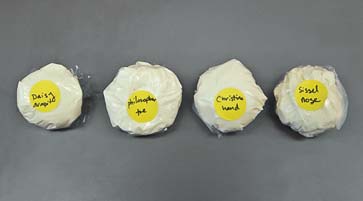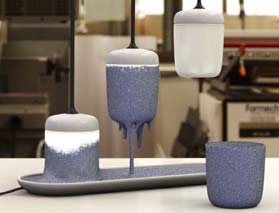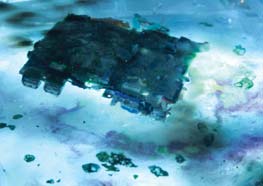3: Impacts of Research into Synthetic Biology: Novel Cultural Artefacts; Improved Policy
Submitting Institution
University of EdinburghUnit of Assessment
SociologySummary Impact Type
CulturalResearch Subject Area(s)
Education: Specialist Studies In Education
Studies In Human Society: Policy and Administration, Sociology
Summary of the impact
Work on synthetic biology carried out by Calvert and Frow at the Univ. of
Edinburgh since 2007 has led to two different types of impact: on
creativity, culture and society; and on public policy. Their research on
design in synthetic biology involved artists and designers from across the
world. It has resulted in the production of novel cultural artefacts
(exhibited in France, Austria, Ireland, the USA and Japan and viewed by
28,000 unique visitors to our website) as well as dedicated events, which
have provided new opportunities for public discussion about synthetic
biology and the design of living things. Their research findings on the
importance of the early-stage involvement of social scientists in
synthetic biology and the role of responsible innovation in the field were
taken up in the UK Synthetic Biology Roadmap and have led to changes in UK
research policy.
Underpinning research
Synthetic biology is the design and construction of new biological
entities for useful purposes. Calvert (University of Edinburgh since 2007)
and Frow (University of Edinburgh since 2006) have been carrying out
research into the nature and implications of this emerging field for the
last five years.
Calvert and Fujimura (2011) and Frow and Calvert (2013b) draw attention
to the challenges of interdisciplinary collaborations across disciplines
such as biology, engineering, computer science, physics and mathematics,
which have different assumptions and objectives. They also point to the
unexpected insights about the biological world that such collaborations
can bring. Extending the discussion of interdisciplinarity a step further,
Calvert has argued for the valuable contributions that social scientists
can make to emerging fields such as synthetic biology, by becoming
involved at an early stage as collaborators in the production of
scientific knowledge (Calvert and Martin 2009).
Calvert and Frow have taken these arguments forward in research into the
`anticipatory governance' of synthetic biology (Wiek et al. 2012). This
work concludes that two key features of successful anticipatory governance
are a) engagement with a variety of lay publics and stakeholder groups
(who often have divergent preferences, expectations and concerns), and b)
the close integration of the natural sciences and engineering with the
social sciences, arts and humanities. Such engagement and integration
enables discussion about what `responsible innovation' might look like
across different disciplinary fields, and across different communities of
knowledge and practice.
Frow and Calvert (2013a) have developed these ideas in a study focused on
the future of synthetic biology, where they have shown that it is possible
to generate a diversity of possible futures of synthetic biology that
challenge familiar narratives, by involving a broader range of
stakeholders and perspectives than is usually the case.
Finally, Calvert (2010) has found that notions of `design' are central to
synthetic biology, and draws attention to the pressing social and ethical
issues that arise when living things are themselves the object of design.
Occasional collaborators in the above research include Joan Fujimura,
University of Wisconsin, and Dave Guston and Arnim Wiek, Arizona State
University. The impacts detailed in section 4.2 were achieved jointly with
Claire Marris and Nikolas Rose (both King's College London).
References to the research
Calvert, J (2010) `Synthetic biology: constructing nature?' in Parry, S
and Dupré, J (Eds) Nature After the Genome Sociological Review
Monographs, Oxford: Wiley-Blackwell, available from HEI.
Calvert, J and Fujimura, J (2011) `Calculating life: Duelling discourses in
interdisciplinary systems biology.' Studies in History and Philosophy
of Biological and Biomedical Sciences 42 (2): 155-163, DOI:
10.1016/j.shpsc.2010.11.022. In REF2.
Calvert, J and Martin, P (2009) `The role of social scientists in
synthetic biology.' EMBO reports, 10 (3): 201-204, DOI:
10.1038/embor.2009.15.
Wiek, A, Guston, D, Frow, E and Calvert, J (2012) `Sustainability and
anticipatory governance in synthetic biology.' International Journal
of Social Ecology and Sustainable Development 3(2): 25- 38, DOI:
10.4018/jsesd.2012040103.
Frow, E and Calvert, J (2013a) `Opening up the future(s) of synthetic
biology.' Futures, 48: 32-43, DOI: 10.1016/j.futures.2013.03.001.
Frow, E and Calvert, J (2013b) `"Can simple biological systems be built
from standardized interchangeable parts?" Negotiating biology and
engineering in a synthetic biology competition.' Engineering Studies
5(1): 42-58, DOI: 10.1080/19378629.2013.764881.
Underpinning research grant:
2009-2011: Synthetic aesthetics: connecting synthetic biology and
creative design. Jane Calvert PI, with Alistair Elfick (Edinburgh) and
Drew Endy (Stanford). EPSRC/NSF Synthetic Biology Sandpit grant: £335,254
(£131,533 EPSRC contribution: EP/H01912X/1).
Details of the impact
4.1 Impacts on creativity, culture and society
Building on her research that demonstrated the importance of
interdisciplinary collaborations in synthetic biology (Calvert and
Fujimura 2011, Frow and Calvert 2013b) and the potentially profound
significance of designing living things (Calvert 2010), Calvert initiated
and led a project to bring together six synthetic biologists with six
professional artists and designers from Europe, the US, Japan and
Australia in paired exchanges. This EPSRC/NSF project, called `Synthetic
Aesthetics', was developed in collaboration with two engineers at a
`Sandpit' event held in Washington DC (30th March — 3rd April 2009).
The project has led to the production of cultural artefacts that would
not have existed otherwise, such as: human cheese made from bacteria
collected from body parts including feet, noses and armpits (winner of the
UdK Award for Interdisciplinary Art and Science from the Universität der
Künste, Berlin in 2012: see Figure 1); a `design fiction' future packaging
that creates a probiotic drink with the addition of water (recipient of a
notable mention in the Core77 2012 Design Awards: see 5.3 and Figure 2);
and cyanobacteria that digest computer circuit boards (see Figure 3). Such
unconventional uses of synthetic biology have stimulated debate among
stakeholders and publics, building on arguments we make in our
underpinning research about the importance of increasing the diversity of
voices that are able to contribute effectively to discussions of synthetic
biology.
 Figure 1
Figure 1
 Figure 2
Figure 2
 Figure 3
Figure 3
The project has reached a broad range of international audiences, and the
artefacts have been exhibited in France, Austria, the Republic of Ireland,
the USA and Japan. The Synthetic Aesthetics website has attracted over
28,000 unique visitors, and the project has over 1500 Twitter followers.
The work has been discussed in journals with wide readership such as Science
(see item 5.6), Nature (5.5) and Cell (5.2), and
newspapers such as the Toronto Standard (5.4) and Der
Tagesspiegel (5.1). The project team members have given over 50
talks on the project across the world, including a dedicated event at the
Edinburgh International Science Festival in 2012, with an audience of 66.
Additionally, a popular book with over 100 images is in production with
MIT Press, and it will be launched at an event at the Museum of Modern Art
in New York in early 2014. Most significantly, in the book the artists and
designers co-authored chapters with their paired scientists and engineers.
This was something none of project's participants had done before, and it
required them all to modify their practices and re-think their
assumptions.
In 2010, Calvert and colleagues received follow-on funding from the
Wellcome Trust and the Royal Academy of Engineering to collaborate with
the Arts Catalyst, a not-for-profit arts/science organisation. Together
they organised a week-long art/science workshop with 28 participants, a
film night with 70 attendees and a public debate with 52 attendees.
Evaluation interviews were carried out with participants after the
workshop, and they noted how the art/science work stimulated creativity
and promoted mutual understanding across disciplines. For example, one
artist participant commented: "it was really enlightening and somewhat
revealing of the way that we talk about each other's disciplines and the
way we do our work. I definitely left feeling like everybody's
inadequately educated".
In sum, the unusual interdisciplinary collaborations instigated by the
Synthetic Aesthetics project have given rise to new cultural artefacts and
to new opportunities for public discussion about synthetic biology and the
hopes and concerns provoked by attempts to design living things.
4.2 Impacts on public policy
Calvert and Frow's published research on (and close engagement with) the
synthetic biology community has led to invitations to join national and
international policy advisory committees including: the Royal Academy of
Engineering Working Party on Synthetic Biology, the BBSRC Bioscience for
Society Strategy Panel, the Nuffield Council on Bioethics Working Party on
Emerging Biotechnologies, the EU-US Task Force on Biotechnology Working
Party on Synthetic Biology, and the Hastings Center Working Group on
Ethical Issues in Synthetic Biology, US. In addition, Frow has been
working with the British Standards Institute and the US National Institute
of Standards and Technology to inform national standards development
initiatives in synthetic biology. For this case study, however, we focus
on one key example of policy impact: the UK's Synthetic Biology Roadmap
(item 5.10).
In early 2012, Calvert (along with Claire Marris and Nikolas Rose) was
invited to join the Synthetic Biology Roadmap Coordination Group (RCG),
established by David Willetts, Minister of State for Universities and
Science, and chaired by Lionel Clarke of Shell. Calvert's, Marris's and
Rose's research findings on the importance of the involvement of the
social sciences in synthetic biology, specifically in respect to
`responsible innovation', were taken up in the Roadmap, which has as one
of its recommendations that "Public sector investment in synthetic biology
should take into account social, ethical and regulatory issues and
increase awareness of responsible innovation" (item 5.10, p.31).
Calvert's, Marris's and Rose's arguments for widening disciplinary
engagement in scientific governance also contributed to the recommendation
that social scientists should be members of a Synthetic Biology Leadership
Council (p.32), and that one meeting per year should be held in public.
This recommendation aims to facilitate democratic participation in the
field, and it differentiates the work of the Synthetic Biology Leadership
Council from all existing leadership councils. As a direct result of these
recommendations, in late 2012 the Synthetic Biology Leadership Council
(jointly chaired by Willetts and Clarke) appointed a social science member
(Prof Joyce Tait: see Case Study 4, Life Sciences Innovation).
The significance of the involvement of Calvert, Marris and Rose in the
Roadmap Coordination Group was demonstrated in a symposium on synthetic
biology in Washington, DC (jointly organised by the National Academies of
the US, the UK and China), where a senior representative from the
Department for Business, Innovation & Skills publicly stated how the
involvement of social scientists (Calvert, Marris and Rose) in the
roadmapping exercise had challenged and reshaped thinking within the UK
government:
"something we've done that is perhaps slightly different from what
we've done in the past is to be more involved with social scientists in
the process right from the outset. That's made a real difference to
actually how we're thinking as a group, and how we've begun to think
within government itself, and that's been, for me, as part of the
journey we've gone on, a real revelation actually" (item 5.9).
The impact of social scientific involvement in this work has reached
beyond the Synthetic Biology Roadmap. This is shown in an email from the
Technology Strategy Board's representative on the RCG on its £6.5 million
funding competition for Feasibility Studies in synthetic biology:
"You will note that `responsible innovation' figures large in the
competition, and that we plan to carry out an ethical, societal and
regulatory assessment on every project funded through it before awarding
the grants. The work of the RCG [Roadmap Coordination Group], with input
from the workshops, has been highly influential in shaping this — the
first time that any Technology Strategy Board competition has taken this
approach. Many thanks, especially to social science colleagues, for
helping to shape the thinking" (email from Head of Development,
Technology Strategy Board, 10th May 2012, on file at the University of
Edinburgh).
Since the publication of the Roadmap, the idea of `Embedding Responsible
Research and Innovation' has been taken up by a £10M call for an
Innovation and Knowledge Centre by the EPSRC, the Technology Strategy
Board and the BBSRC (5.8), and an £80M call for six Synthetic Biology
Research Centres by the BBSRC and the EPSRC, demonstrating the
significance of this work for ongoing policy initiatives (5.7). Calvert
and Frow have also been invited to contribute to the development of the
Technology Strategy Board's `Responsible Innovation Framework', which will
be used in future decisions about funding in the area of synthetic
biology. Note re testimony: other than the artist quoted (who was a
participant in the workshop), none of those quoted were participants in
the process of impact delivery.
Sources to corroborate the impact
In case of broken links, PDFs of all weblinks are available at: www.wiki.ed.ac.uk/display/REF2014REF3B/UoA+23
Synthetic Aesthetics: impacts on creativity, culture and society
5.1 Bauer, UM, Goltz, S (2012) `Kunst in der Wissensgesellschaft (Art in
the Knowledge Society)' Der Tagesspiegel (19 April 2012). Online
at: http://www.tagesspiegel.de/zeitung/kunst-in-der-
wissensgesellschaft/6503380.html
5.2 Bernstein, R (2011) `Drop that Pipette: Science by Design.'Cell
147 (28 Oct 2011): 496-497,http://tinyurl.com/pbsaxec.
5.3 Core77 Design Awards (2012) `Future Visions for Synthetic Biology.'
Online at:
http://www.core77designawards.com/2012/recipients/future-visions-for-synthetic-biology/
5.4 Cormier, Z (2011) `Bacterial culture.' Toronto Standard (25th
April 2011). Online at: http://www.torontostandard.com/culture-design/bacterial-culture
5.5 Gewin, V (2013) `Interdisciplinarity: Artistic merit.' Nature
496 (7446): 537-539, DOI: 10.1038/nj7446-537a
5.6 Reardon, S (2011) `Visions of synthetic biology.' Science 333
no 6047 (2nd Sept 2011): 1242-1243, DOI: 10.1126/science.333.6047.1242.
UK Synthetic Biology Roadmap: impacts on public policy
5.7 BBSRC and EPSRC (2013) `Multidisciplinary research centres in
synthetic biology.' Online at:
http://www.bbsrc.ac.uk/web/FILES/PreviousAwards/multidisciplinary-research-centres-in-synthetic-
biology-background.pdf
5.8 EPSRC, TSB and BBSRC (2012) `Call For expressions of interest for an
Innovation and Knowledge Centre (IKC) in synthetic biology.' Online at:
http://www.epsrc.ac.uk/SiteCollectionDocuments/Calls/2012/IKCForSyntheticBiologyEOI.pdf
5.9 Uffindel, D (2012) talk on `Perspectives on synthetic biology from
within the political system' at Synthetic Biology for the Next Generation:
The Six Academies Symposium, Washington, DC, June 12-13, 2012, viewable
online at:http://events.tvworldwide.com/Events/IOM/NAS120612.aspx?VID=events/nas/120612_NAS_SyntheticBiology_1415.flv
5.10 UK Synthetic Biology Roadmap Coordination Group (2012) A
Synthetic Biology Roadmap for the UK Technology Strategy Board:
Swindon. Online at: http://www.rcuk.ac.uk/documents/publications/SyntheticBiologyRoadmap.pdf
Individual users/beneficiaries who could be contacted to corroborate
claims:
The impact of the Synthetic Aesthetics project on art/science
collaborations and its role in initiating discussion of synthetic
biology amongst artists and designers can be corroborated by:
Director, The Arts Catalyst, London, UK (a not-for-profit arts/science
organisation)
Principal, The Living, New York, USA (an architecture firm)
The impact of Calvert, Marris and Rose's involvement in the UK Synthetic
Biology Roadmap can be corroborated by:
Head of Bio-Economy Unit, Department for Business, Innovation and Skills,
London, UK
Head of Development, Technology Strategy Board, London, UK